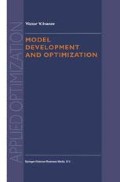Abstract
With a view to the best comprehension of objects investigated, various examples of evolutionary systems (ES) are considered. There are three classes of ES: Artificial ES (AES) being created or already created by human beings and functioning with their participation, Natural ES (NES), and Joined ES (JES). The principal attention of this chapter is recognition of common properties, among ES, and differences, between AES and NES. We study mainly structure-functional properties of ES that are independent on the specific character of ES, for example, on separate countries or species of plants.
Access this chapter
Tax calculation will be finalised at checkout
Purchases are for personal use only
Preview
Unable to display preview. Download preview PDF.
References
Curtis H., Biology, Worth Publishers, Inc, 1984, 1159 pp.
Davydov A.S., Biology and Quantum Mechanics, Kiev: Naukova dumka, 296 pp. (in Russian)
Economic Policy and Development: New Perspective, Auburn House Publishers Co., 1985, 320 pp.
Element, The Encyclopedia Americana, Intern. Edition, Grolier Inc., 10, 1990, 203–209.
Halvorson G.G., Strong Medicine, Random House, 1993, 253 pp.
Levine A.J., Viruses, Science Amer. Library, 1992, 240 pp.
Managing Planet Earth, Reading from Science Amer. Magazine, 1990, 146 pp.
Photosynthesis, The Encyclopedia Americana, Intern. Edition, Grolier Inc., 22, 1990, 38–41.
Tsvetkov V.Ya., Fifteen Stone of Reandzi’s Garden, Politizdat, 1991, 414 pp. (in Russian).
Vernadsky V.I., Living Substance, M.: Nauka, 1978, 240 pp. (in Russian).
Volterra V., Theory of Functional and of Integral and Integro-Diflerential Equations, Dover Publications, 1959, 340 pp.
Volterra V., Mathematical Theory of Fighting for Existence, M.: Nauka, 1976, 222 pp. (in Russian).
Author information
Authors and Affiliations
Rights and permissions
Copyright information
© 1999 Springer Science+Business Media Dordrecht
About this chapter
Cite this chapter
Ivanov, V.V. (1999). Evolutionary Systems. In: Model Development and Optimization. Applied Optimization, vol 28. Springer, Boston, MA. https://doi.org/10.1007/978-1-4615-4062-5_1
Download citation
DOI: https://doi.org/10.1007/978-1-4615-4062-5_1
Publisher Name: Springer, Boston, MA
Print ISBN: 978-1-4613-6819-9
Online ISBN: 978-1-4615-4062-5
eBook Packages: Springer Book Archive

